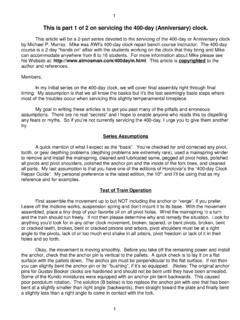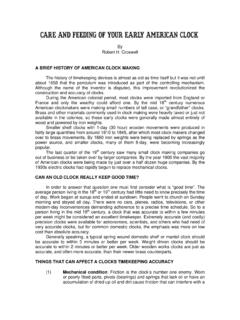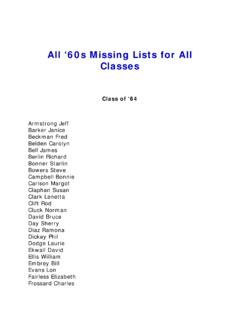Transcription of The Levers of American Striking Movements - Horology
1 The Levers of American Striking Movements David J. labounty March, 2001 CMC, MBHI Revised, October, 2001 Life Member NAWCC Life Member AWI All Rights Reserved Table of Contents Part 1: Warning Wheel as Stop Configuration ..3 The Levers - 3 Working Together - 6 Wear Problems - 10 Repairing Severe Damage - 15 movement Assembly - 16 Adjustments and Clearances - 17 movement at Stop - 17 movement in Warning - 20 movement in Strike - 23 Strike Release Points - 26 Oiling - 27 Useful Tool - 28 Final Adjustment - 28 Part 2: Maintenance Cam as Stop Configuration ..29 The Levers - 29 Working Together - 32 Wear Problems - 35 Repairing Severe Damage - 41 movement Assembly - 42 Adjustments and Clearances - 44 movement at Stop - 44 movement in Warning - 47 movement in Strike - 49 Strike Release Points - 52 Oiling - 53 Final Adjustment - 54 Adapting This to Your movement .
2 55 Resources and Additional Reading ..56 1 The Levers of American Striking Movements By David J. labounty CMC, MBHI INTRODUCTION American movement strike lever arrangements are a bit more complicated than they look. The first time I was asked to adjust one of these (and I m quite sure I was set up) I was able, after a bit of bending and guesswork, to get the Levers to cooperate and do what they were supposed to do. During the course of trying to figure out just what they were for, however, I found myself adjusting in circles and getting more frustrated with each adjustment. Unbeknownst to me, the movement I was handed was one of those with which even the best of us has problems. The Levers have to be adjusted just right or suffer the consequences.
3 This exercise taught me the lesson that proper lever adjustments are key to the reliability of the movement . It doesn t matter how well the rest of the movement is restored, if the Levers haven t received the proper attention there will be problems with running, Striking , or both. The following is a presentation of two generic lever arrangements which, hopefully, will enable you to understand specific and unique lever configurations. The first configuration, most commonly found in eight-day Movements such as the Seth Thomas model 89 s and others, has a stop/warning pin on the 4th wheel (see fig. 1). The hammer pins in this configuration are on the maintenance cam (I) or 3rd wheel. The second configuration discussed later in Part 2 , found in thirty-hour and some 8-day clocks, uses the maintenance cam (I) as the stop/lock and has the warning pin on the butterfly.
4 The hammer pins are commonly found on the 2nd wheel (J). This work was designed to be a bench-side aid, which is why some information is identical in parts 1 and 2. It may be advisable, therefore, to have an American , count wheel, Striking movement on hand to aid the reader in identifying the Levers and their relationships while reading this material. 2 History American strike Levers have their roots in the strike work of English and European timepieces. As is often the case, advancements in Horology are brought about by necessity. Those clockmakers who ventured to America in the eighteenth century brought an intimate knowledge of the methods of obtaining a reliable Striking process. Unfortunately, the materials available to them for producing timepieces and strike work were costly, as they had to be imported.
5 Only the wealthy could afford to own a Striking clock in America in the eighteenth century and the number was so small many clockmakers turned to other trades. It was therefore a relatively short time before the necessity for producing an inexpensive timepiece brought about changes in the construction of Movements . Eli Terry s patent in 1816 of an inexpensive Striking clock movement shows the ingenuity and adaptability of clockmakers. Terry found American hard woods to be a readily available, inexpensive material to replace the brass of the Movements . This allowed him to mass-produce timepieces which the common American could afford. Many clockmakers followed his example and over the next few years the profit in producing an American clock was sufficient that an industry was born.
6 The Levers of Striking clocks became thin, inexpensive segments of soft steel wire, instead of the thick, flat pieces of wrought iron common to clocks of the previous century. They were affixed to wooden arbors, easy to produce, and readily adjustable. They varied slightly from manufacturer to manufacturer but still retained the basic form and function of their English counterparts. This is not to say certain elements were not rearranged. One example is the innovation of relocating the strike release pin(s) which were moved from the minute wheel to the rear of the center shaft. The invention of rolled brass in the mid nineteenth century allowed American clockmakers to return to producing clock Movements out of sturdier material. The brass was thin, inexpensive, relatively hard, and didn t need to be imported.
7 The strike Levers were again affixed to steel arbors but retained their soft steel wire construction, as it was easy to produce and adjust. Relatively few changes took place in the construction, shape, or function of American strike Levers over the next seventy years and it wasn t until the 1920 s that they once again became flat pieces of steel reminiscent of their early English counterparts. Instead of being cast, hand-made pieces, these Levers were machine stamped out of steel sheets. The process was accurate enough that very little adjustment of the Levers was required and, in fact, this style of lever was adjustable only by rotating it on the arbor. Sadly, the American clock industry is now all but nonexistent and no American Striking clocks are being mass-produced.
8 Korea, China, and Japan are producing Movements with strike work virtually identical to those the American clock industry was producing at its peak and these Levers will still be encountered in new clocks today. 3 Part 1: WARNING WHEEL AS STOP CONFIGURATION Figure 1 THE Levers (fig. 1 - 3) In order to discuss the Levers we must first identify them and describe their function. Note: These are grouped according to the arbor to which they are attached. A Stop lever : This lever stops the strike train by intersecting the path of the stop pin mounted on the stop/warning wheel (H). B Maintenance lever : The function of this lever is two fold. First, this lever maintains the clearances needed for the stop lever (A) and the count lever (C) when continuing the strike process.
9 This allows the strike train to run until stop conditions are met. Second, the maintenance lever (B), by dropping into the notch in the maintenance cam (I), allows the stop lever (A) and count lever (C) to fall into a stop/lock position. C Count lever : This lever counts the strike by being held up until it falls into a stop notch on the count wheel (K). When the count lever (C) drops into a deep or stop notch on the count wheel (K), the maintenance lever (B) is allowed to drop deeper into the notch on the maintenance cam (I), and the stop lever (A) drops far enough to catch the stop pin stopping the strike process. Strike will continue as long as the count lever (C) is resting on the rim of the count wheel (K) and not in a stop notch.
10 4 Figure 2: lever detail. D Lift lever : This lever s function is to lift the stop lever (A), maintenance lever (B), and count lever (C) so that the strike train is released from the stop position. E Warning lever : This lever catches the warning pin (same as the stop pin in this instance) and holds the strike train until the precise point of strike release is reached. The short amount of release (or run) and arrest of the strike train just prior to strike is called warning. F J lever : This lever , called the J lever because of its shape, could just as well be called the strike release lever as its function is to release the strike train from stop into warning and from warning into strike at specific times. It is also the means by which the other Levers are lifted into position for the coming strike action.










